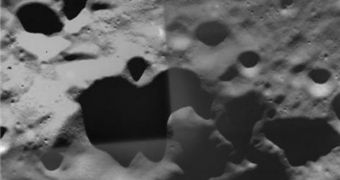The European Space Agency (ESA) launched its Small Missions for Advanced Research in Technology (SMART-1) satellite in an orbit around the Moon on September 27, 2003. Over the next three years, the spacecraft conducted scientific observations of Earth's natural satellite. On September 3, 2006, it was deliberately crashed into the lunar surface, at a speed of about 2,000 meters/second (4,500 miles per hour). Apparently, even after its “death” it still helped scientists have a better understanding of the Moon. Its former control team has released an image of crater Cabeus-A, where NASA's Lunar Crater Observation and Sensing Satellite (LCROSS) is scheduled to crash in October.
The LCROSS spacecraft carries with it a spent Centaurus rocket stage, which it plans to drop in the crater over the next few weeks. As the huge chunk of metal impacts the crater, LCROSS will photograph the dust plume that will form. Experts hope that its sensitive instruments will be able to pick up signs of water-ice among the debris. In October, LCROSS' orbit will be purposefully degraded, and the craft will fall to the same Cabeus-A crater. This time, telescopes in Earth's orbit and on the ground will be pointed at the site.
The most sensitive spectrometers will also conduct surveys of the ensuing debris plum. Mission controllers say that, if water-ice indeed exists in the crater, then it will most definitely be exposed. In the meantime, NASA engineers use all available Cabeus-A pictures to assess the conditions at the impact site. The new SMART-1 image shows this particular crater in great detail, and gives the scientists a better clue of what they are dealing with. Four years ago, when the image was taken, solar elevation and direction were the same as they will be during LCROSS' final descent.
“We are pleased to contribute these ESA SMART-1 observations of the LCROSS target site in order to help in the planning and interpretation of impact observations. This is like gathering evidence for a Crash Scene Investigation, but before the action takes place. The coordination and exchange of information between lunar missions is an important step for future exploration of the Moon. Cooperation is vital if we are ever to see ‘villages’ of robotic landers and eventual lunar bases, as recommended by the International Lunar Exploration Working Group,” says SMART-1 Project Scientist Bernard Foing, quoted by AlphaGalileo.

 14 DAY TRIAL //
14 DAY TRIAL //